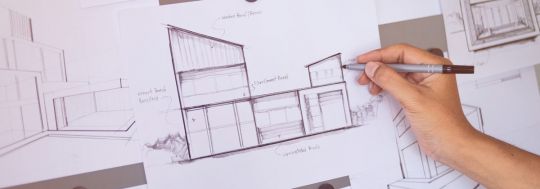5 tips when designing your home

When designing your home, you want to get it right from the start. A property expert shares her key considerations when designing your dream home.
I’ve inspected a fair few properties in my recent search to get my foot onto the property ladder. I’ve seen so many different layouts and design features, and a little too often what seems like a complete lack of thought given to the useability of the space. I frequently found myself muttering behind my face mask: Why is there no pantry or microwave space? Do I not store food or need bench space? Sure Mr Real Estate Agent, I could totally squeeze my table against that wall, then learn parkour to manoeuvre the 10cm space between it and the couch. Who needs natural light or a breeze in the bedroom? It’s only where you spend a third of your life…
After this experience, I can understand why people decide to design their own living space. It gives homeowners the opportunity to make sure the space is functional and suits the way they choose to live. But it is something you want to get right from the conceptualisation to avoid costly corrections after the property is built. So what are some key considerations when you are designing your dream home?
Senior Property Advisor at Herron Todd White, Belinda Botzolis, has worked with a number of clients providing property appraisals based on floorplans, and has seen her fair share of mishaps in the design process. Here are Belinda’s five tips when designing your home.
">1. Don’t forget the study

With the working-from-home landscape changed forever due to the COVID pandemic and the rise of the ‘great resign’ leading to negotiations on working conditions, many people are working from home in some capacity – either on a part-time or full-time basis. So incorporating a designated study space has become important in a new build or major renovation. Study nooks are out as people are finding a small space near the kitchen just doesn’t allow for privacy for a Zoom meeting. An actual designated office/study space where someone can work and there is enough room for two screens is a likely prerequisite for future home buyers.
2. Capture natural light
The most sought-after aspect for any property is north to northeast. This aspect means that natural light will most likely fill your home for the majority of the day, making it lighter and brighter.
Facing windows toward the northern aspect can be key. If your home does not face north, it is not at a complete loss as skylights, smart window placements and lighter interior colour schemes can give the illusion of light and bright spaces.
You may want to avoid placing large windows facing west, because that westerly summer sun can be unforgiving on a hot Aussie summer’s afternoon. It can also affect your NatHERS rating and be expensive to cool.
3. Bring back decent-sized bedrooms
Believe it or not, sometimes a three-bedroom house could be valued more than a four-bedroom house. The misconception that the more bedrooms a home has, the more it’s worth, doesn’t apply to every single home. For example, buyers may prefer a three-bedroom home with spacious rooms and possibly an additional smaller study compared to a home with four very small bedrooms that barely fit a bed and side table.
Modern home designs, in my experience, tend to have smaller bedrooms than previous decades. It could be worthwhile to compromise, perhaps by making an oversized living room smaller to allow the bedrooms to be slightly larger.
A key tip is to make sure, when measuring a bedroom, you do not include the built-in wardrobe as part of the floor area. Many builders will give you bedroom measurements that include the built-in, which means the physical floor space is even smaller than you may expect. When you are looking at a floor plan, allow for a space 600 to 800mm wide for the built-in wardrobe (if it’s not already marked on the plan). A decent bedroom should be at least around 3.5mx3.5m (without the built-ins).
4. Avoid dead space
I have valued many homes where the living and dining areas are so massive that furniture placement actually becomes awkward. This is a sign of inefficient design.
The key is thinking through the functionality and useability of that space. Ask yourself, can I do what I need to in this space if it was a little smaller? If the answer is yes, have a play around with the length and width of a room and always imagine furniture placement. For example, where exactly will you be sitting to watch TV and where will the TV hang? Also, are you designing the space to best utilise a window placement for natural light?
Bigger isn’t always better, especially if that space could be utilised differently.
5. Keep it classic, not high fashion
The secret to designing a home that will most likely hold its value is to not follow the latest trends too closely. You want to avoid that feeling when you walk into a home and say, “that was so five years ago”, for example, subway tiles being used everywhere.
Keeping a home neutral, classic and traditional can help to retain its value and typically have a greater market appeal. If you want to experiment with colour and texture and so-hot-right-now trends, consider instead doing it through artwork, furniture, cushions, rugs and even light fittings that are easy to change to get a whole new look. If you still have your heart set on experimenting with bold interior and architectural design trends then understand what you love might not appeal or necessarily resonate with the broader market when it comes time to sell.
Compare Construction Home Loans
Cover image source:SpeedKingz/Shutterstock.com

The comparison rate for all home loans and loans secured against real property are based on secured credit of $150,000 and a term of 25 years.
^WARNING: This comparison rate is true only for the examples given and may not include all fees and charges. Different terms, fees or other loan amounts might result in a different comparison rate.
 Owner occupied
Owner occupied
 30% min deposit
30% min deposit
 Redraw facility
Redraw facility
Try our Home Loans comparison tool to instantly compare Canstar expert rated options.





